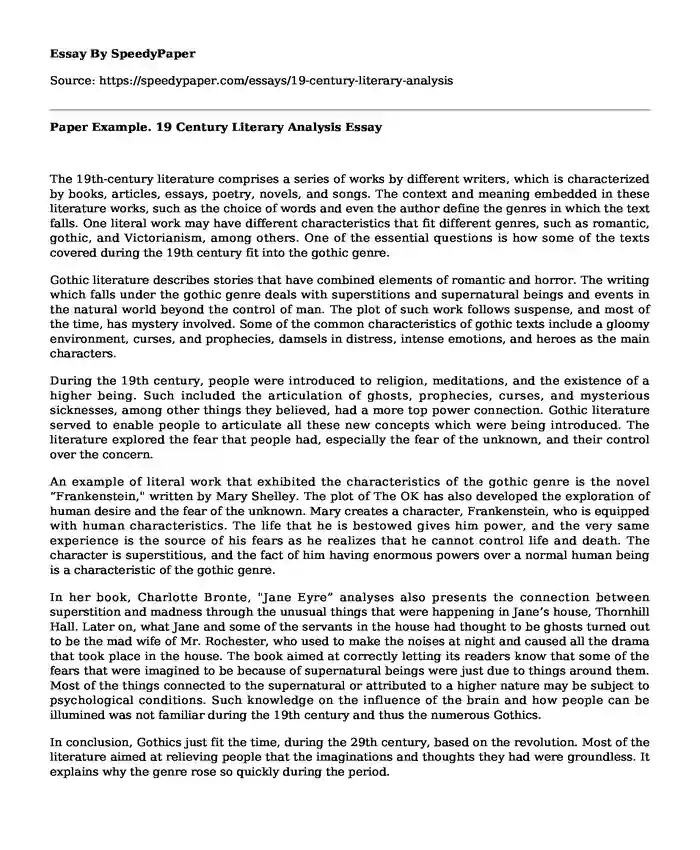
| Essay type: | Book review |
| Categories: | Literature Analysis Jane Eyre Romantic literature |
| Pages: | 2 |
| Wordcount: | 544 words |
The 19th-century literature comprises a series of works by different writers, which is characterized by books, articles, essays, poetry, novels, and songs. The context and meaning embedded in these literature works, such as the choice of words and even the author define the genres in which the text falls. One literal work may have different characteristics that fit different genres, such as romantic, gothic, and Victorianism, among others. One of the essential questions is how some of the texts covered during the 19th century fit into the gothic genre.
Gothic literature describes stories that have combined elements of romantic and horror. The writing which falls under the gothic genre deals with superstitions and supernatural beings and events in the natural world beyond the control of man. The plot of such work follows suspense, and most of the time, has mystery involved. Some of the common characteristics of gothic texts include a gloomy environment, curses, and prophecies, damsels in distress, intense emotions, and heroes as the main characters.
During the 19th century, people were introduced to religion, meditations, and the existence of a higher being. Such included the articulation of ghosts, prophecies, curses, and mysterious sicknesses, among other things they believed, had a more top power connection. Gothic literature served to enable people to articulate all these new concepts which were being introduced. The literature explored the fear that people had, especially the fear of the unknown, and their control over the concern.
An example of literal work that exhibited the characteristics of the gothic genre is the novel “Frankenstein," written by Mary Shelley. The plot of The OK has also developed the exploration of human desire and the fear of the unknown. Mary creates a character, Frankenstein, who is equipped with human characteristics. The life that he is bestowed gives him power, and the very same experience is the source of his fears as he realizes that he cannot control life and death. The character is superstitious, and the fact of him having enormous powers over a normal human being is a characteristic of the gothic genre.
In her book, Charlotte Bronte, "Jane Eyre” analyses also presents the connection between superstition and madness through the unusual things that were happening in Jane’s house, Thornhill Hall. Later on, what Jane and some of the servants in the house had thought to be ghosts turned out to be the mad wife of Mr. Rochester, who used to make the noises at night and caused all the drama that took place in the house. The book aimed at correctly letting its readers know that some of the fears that were imagined to be because of supernatural beings were just due to things around them. Most of the things connected to the supernatural or attributed to a higher nature may be subject to psychological conditions. Such knowledge on the influence of the brain and how people can be illumined was not familiar during the 19th century and thus the numerous Gothics.
In conclusion, Gothics just fit the time, during the 29th century, based on the revolution. Most of the literature aimed at relieving people that the imaginations and thoughts they had were groundless. It explains why the genre rose so quickly during the period.
Cite this page
Paper Example. 19 Century Literary Analysis. (2023, Sep 12). Retrieved from https://speedypaper.net/essays/19-century-literary-analysis
Request Removal
If you are the original author of this essay and no longer wish to have it published on the SpeedyPaper website, please click below to request its removal:
- The Scarlet Letter Essay Example
- Essay Sample on the Impact of Science on the World
- Paper Example. Climate Change and Agriculture in Europe
- Essay Sample on Pricing Analytics in Consumer Products
- Poverty in Fall River and How to Bring About Change. Free Essay
- Essay Example. The Theme of Alienation in Mary Shelley's Frankenstein
- Antigone: Understanding Political Duty and Family Obligation - Essay Sample
Popular categories




